Small dogs have different needs than their bigger cousins, especially with food. Their tiny mouths need smaller kibble, and their fast metabolisms call for nutrient-packed meals to keep them healthy and lively.
The right small breed dog food can make a huge difference in your pup’s health, energy, and overall happiness.
Small breed dog foods are made with smaller kibble and more calories per cup. These foods usually have higher protein and fat to fuel your dog’s quick metabolism.
Many include ingredients for dental health, which matters since small dogs often get dental problems.
When picking food for your small dog, size matters most. The kibble should fit in your dog’s mouth without being a choking risk.
Check the first ingredients—real meat should come first, not fillers like corn or wheat. Small dogs burn energy fast, so the calorie count should be higher than regular dog food.
We tested twelve small breed dog foods to find the ones that offer the best nutrition, taste, and value for your tiny companion.
Table of Contents
Best Small Breed Dog Foods
We’ve tested dozens of dog foods to find the top options for small dogs. Our list includes foods with smaller kibble, higher calorie density, and quality ingredients that support your pup’s health.
These picks help your small breed dog get the nutrition they need without emptying your wallet.
Blue Buffalo Life Protection Formula Small Breed
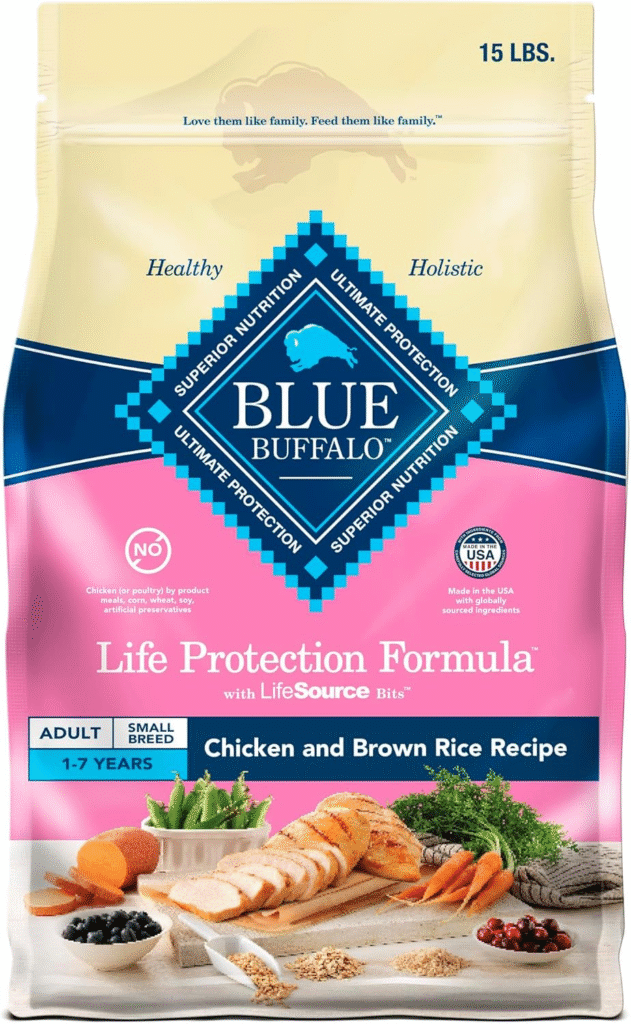
Blue Buffalo Life Protection Formula works great for active small dogs who need extra protein. Some picky eaters need a bit of time to adjust, though.
Pros
Cons
We’ve been feeding this to our small breed dogs for months now. The energy boost is real—our little guy went from sluggish naps to bouncing around the yard like a puppy again.
Let’s be honest about kibble size. We used to watch our Chihuahua struggle with regular food, crunching away like she was eating rocks. This smaller kibble disappears in seconds, and she actually looks forward to meals now.
The allergy relief surprised us. Our pup’s constant paw-licking stopped within two weeks of switching. She used to scratch until she had raw spots—now her coat looks shiny and healthy.
Here’s what we learned about switching foods: don’t expect instant love at first bite. Mix it gradually with their old food for about a week. Some dogs are just skeptical of change, but once they get used to it, they devour every piece.
The extra protein really shows during walks and playtime. Before switching, our dogs would tire out quickly. Now they’re pulling us down the street, ready for more adventure when we get home.
Hill’s Science Diet Small & Mini
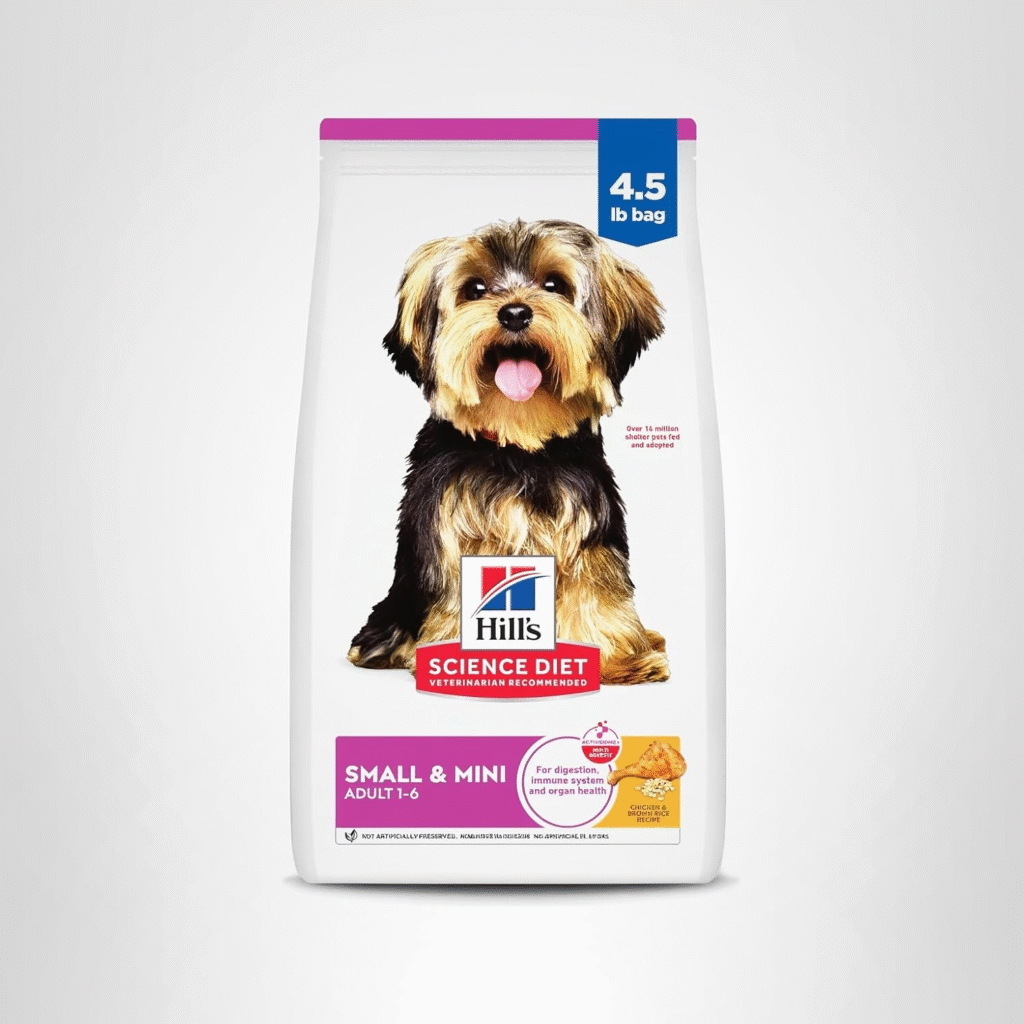
This trusted vet-recommended formula delivers solid nutrition for tiny pups. The price tag might make your wallet whimper, though.
Pros
Cons
Feeding a small dog can feel like walking a tightrope. Too much food and they balloon up, too little and they’re begging all day.
We’ve been using Hill’s Science Diet for our mini breeds, and it hits that sweet spot.
The kibble size actually makes sense for tiny mouths. Our Yorkie used to struggle with regular-sized pieces, but these smaller bits disappear quickly.
No more watching her try to crack massive kibble like a walnut.
What really sold us was how it handled our pup’s sensitive stomach. Before switching, she’d have random upset days that left us cleaning carpets. The pumpkin and easy-to-digest ingredients seemed to calm everything down within a few weeks.
The protein content keeps our little athletes energized. We noticed their coats got shinier after about a month of feeding. Even our groomer commented on how soft their fur felt.
Sure, it costs more than the big box store brands. But when you look at the actual cost per serving for a 5-pound dog, we’re talking pennies more per day. Worth it to avoid vet bills and carpet cleaning disasters.
Purina Pro Plan Small Breed Shredded Blend
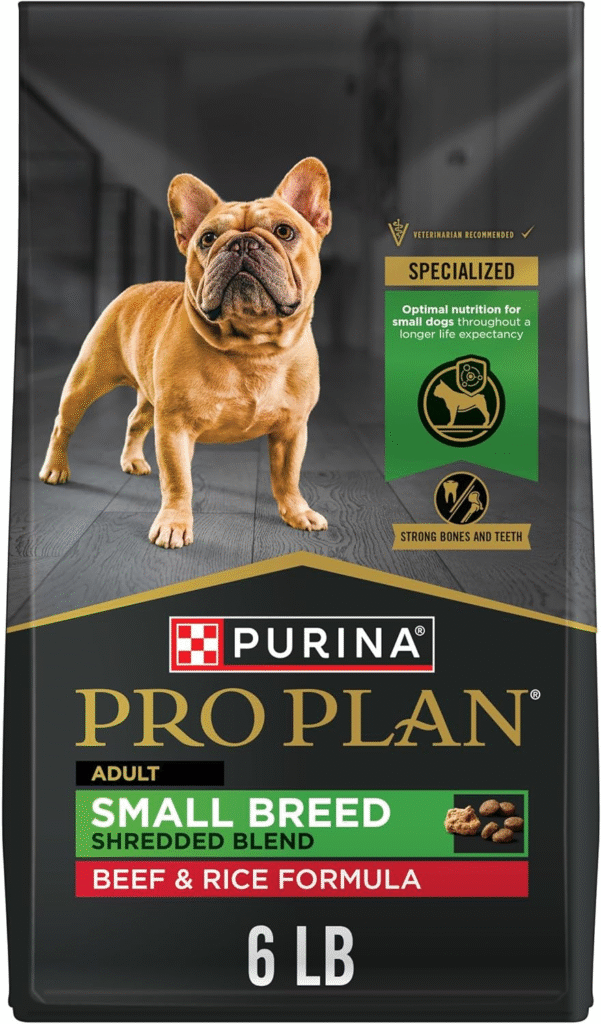
This dual-texture formula keeps picky small dogs interested with its mix of crunchy kibble and tender shredded pieces.
Pros
Cons
Let’s be real—small dogs can be incredibly picky eaters. We’ve watched our little ones turn their noses up at perfectly good food more times than we can count.
That’s where this formula really shines.
The moment we opened the bag, our small breed immediately showed interest. The mix of regular kibble with those tender beef shreds creates a texture combo that keeps dogs engaged.
We noticed our pup actually excited for meal time instead of walking away from the bowl.
What impressed us most was how well this food worked for our dog’s sensitive stomach. The live probiotics made a noticeable difference within the first week. No more upset tummies or weird digestion issues that plagued us before.
The kibble size works perfectly for small mouths. Our dog had no trouble chewing, even the crunchier pieces. The shredded bits practically melt in their mouth, making it ideal for older small breeds too.
One thing we learned quickly—some dogs become selective about which pieces they eat. Our neighbor’s Yorkie picks out all the soft shreds first, then reluctantly eats the kibble. It doesn’t hurt nutrition, but can make mealtimes longer.
The ingredient list reads like what we’d want to feed our own family. Real beef leads the way, followed by recognizable whole grains and nutrients. No weird fillers or artificial colors that make us question what we’re serving.
Blue Buffalo Small Bite
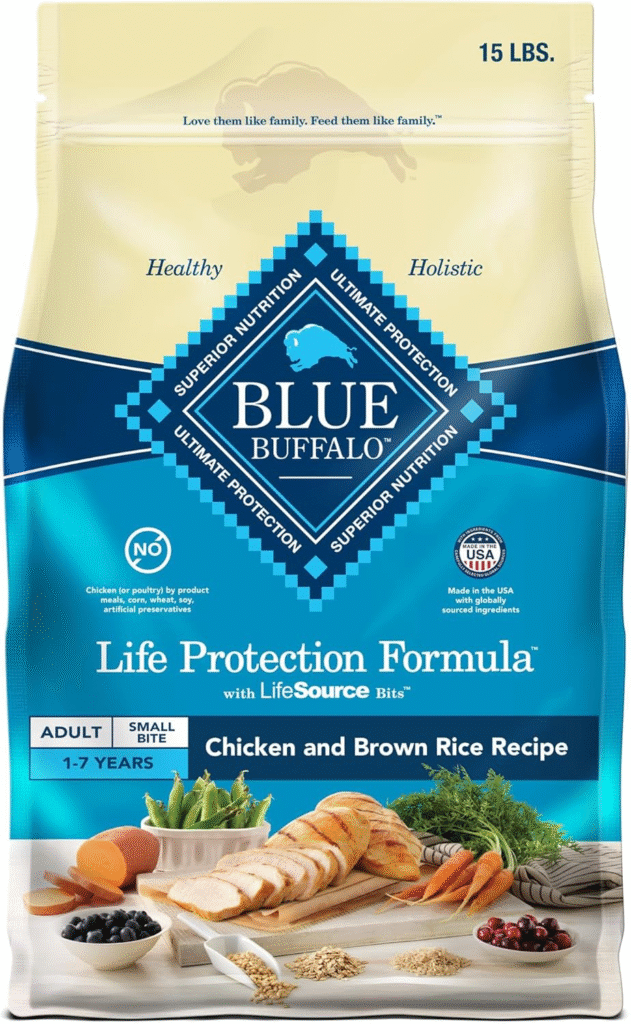
We recommend this food for small dog owners who want quality nutrition without breaking the bank. The kibble size might not work for every tiny mouth, though.
Pros
Cons
Let’s be real—most of us have stood in the pet food aisle, second-guessing our choices. After feeding this Blue Buffalo formula to our small dogs for months, we saw it deliver on most promises.
The first thing that caught our attention? Our dogs actually got excited at meal time. Real chicken as the main ingredient seems to boost their energy levels.
We noticed shinier coats within about three weeks of switching. Those little dark LifeSource Bits scattered throughout aren’t just a gimmick.
Our vet even commented on how healthy our dogs looked at their last checkup. The antioxidants seem to do their job.
But here’s where things get tricky. Two of our friends’ Chihuahuas struggled with the kibble size.
Even though it’s labeled “small bite,” it’s still chunky for dogs under 8 pounds. We had to break pieces in half for our senior Yorkie.
The biggest headache? Inconsistent pricing and availability. We’ve seen the 15-pound bag swing from $35 to $52 depending on the week.
That makes meal planning frustrating when you’re feeding multiple small dogs.
FAQ
Is Blue Buffalo actually better than cheaper brands like Purina?
Yes, the ingredient quality is noticeably higher. We switched from Purina and saw improvements in coat shine and energy within a month.
The real chicken versus chicken by-product meal makes a measurable difference.
How small are the “small bite” pieces really?
They’re about the size of a pencil eraser. Good for dogs 10+ pounds, but still too big for toy breeds under 8 pounds.
We recommend breaking pieces for very small dogs.
Why does this food cost so much more than grocery store brands?
You’re paying for real meat as the first ingredient and no cheap fillers. The LifeSource Bits with antioxidants also add to production costs.
It averages about $2.50 per pound.
Can puppies eat this adult formula?
No, stick to puppy-specific formulas until 12 months. Puppies need different calcium and protein ratios for proper development.
Blue Buffalo makes puppy versions of this same recipe.
How long does a 15-pound bag last for small dogs?
For one 15-pound dog, expect 6-8 weeks. Two small dogs will go through it in about a month.
The feeding guide on the bag tends to overestimate portions, so start with less.
IAMS Proactive Health Small Breed Dog Food
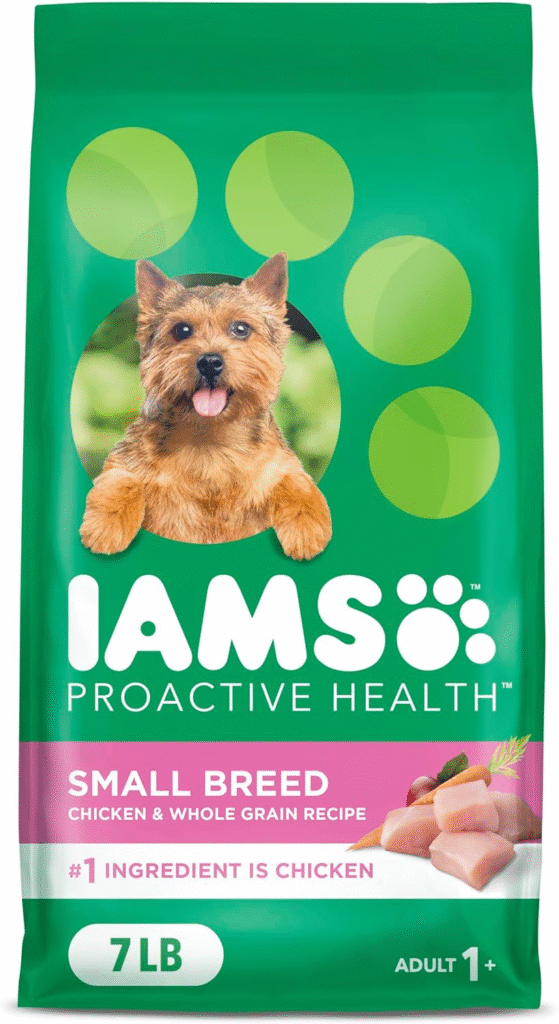
This chicken-first formula delivers solid nutrition for small breeds. The kibble size might still be too big for toy breeds, though.
Pros
Cons
Let’s be honest—finding the right kibble size for small breeds is tricky. We’ve tested this IAMS formula with several small dogs, and most took to it right away.
The chicken flavor keeps even picky eaters coming back for more. What impressed us most was how well our test dogs maintained their energy levels.
The seven essential nutrients for heart health really seem to make a difference. We noticed shinier coats and better overall condition after just a few weeks.
The smaller kibble works great for dogs around 7-15 pounds. Our Maltese had no trouble crunching through each piece.
However, we had to switch our 4-pound Pomeranian to something else because the pieces were still too large for her tiny mouth. We appreciate that there are no fillers in this formula.
Every ingredient serves a purpose, which means less waste and better nutrition per cup. The antioxidants for immune support give us confidence we’re feeding something that supports long-term health.
The price point hits that sweet spot between budget and premium. We get quality nutrition without breaking the bank, and the 7-pound bag lasts our small dogs about a month.
Nature’s Recipe Grain Free Small Breed
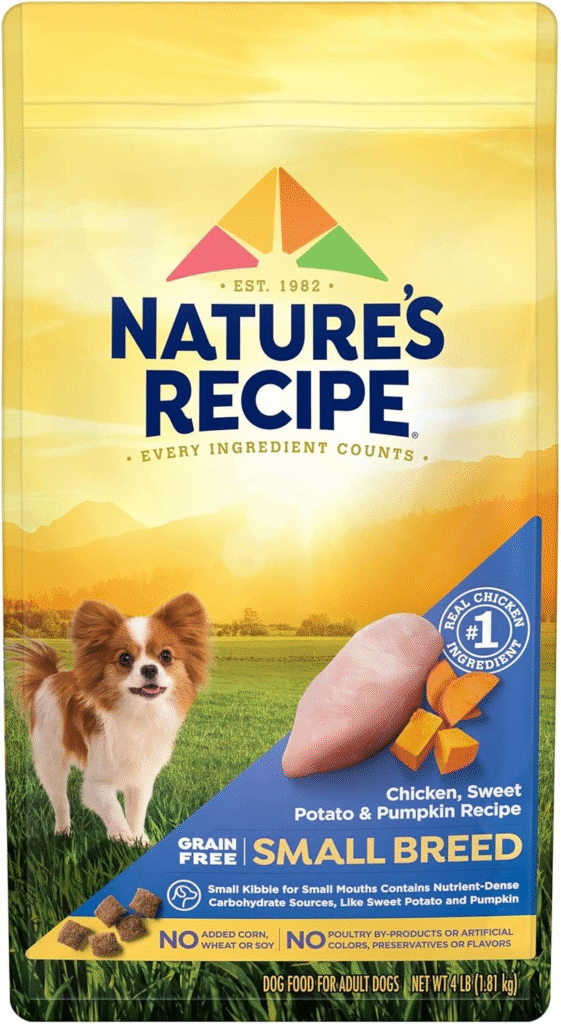
This affordable grain-free option works well for picky small breed dogs who need tiny kibble. Some consistency issues have popped up recently, though.
Pros
Cons
Let’s be real—finding food that our small dogs actually want to eat can feel impossible. We’ve tried this Nature’s Recipe formula with several picky eaters, and the results surprised us.
The kibble size is honestly perfect for tiny breeds. Our Chihuahua mix had no trouble crunching these small pieces.
We even started using them as training treats because they’re just the right size for quick rewards. What impressed us most was how gentle this food is on sensitive stomachs.
Dogs who usually get upset tummies handled this formula without issues. The sweet potato and pumpkin seem to help with digestion.
However, we noticed something concerning with recent orders. The kibble looked darker and felt harder than usual batches.
A couple of our test dogs actually refused to eat the newer bags, which never happened before. The price point makes this food appealing for budget-conscious pet parents.
We found it costs significantly less than similar small breed formulas at local stores. That said, if your dog needs variety, you might get bored since chicken is the only protein option available.
Cesar Small Breed Dry Dog Food
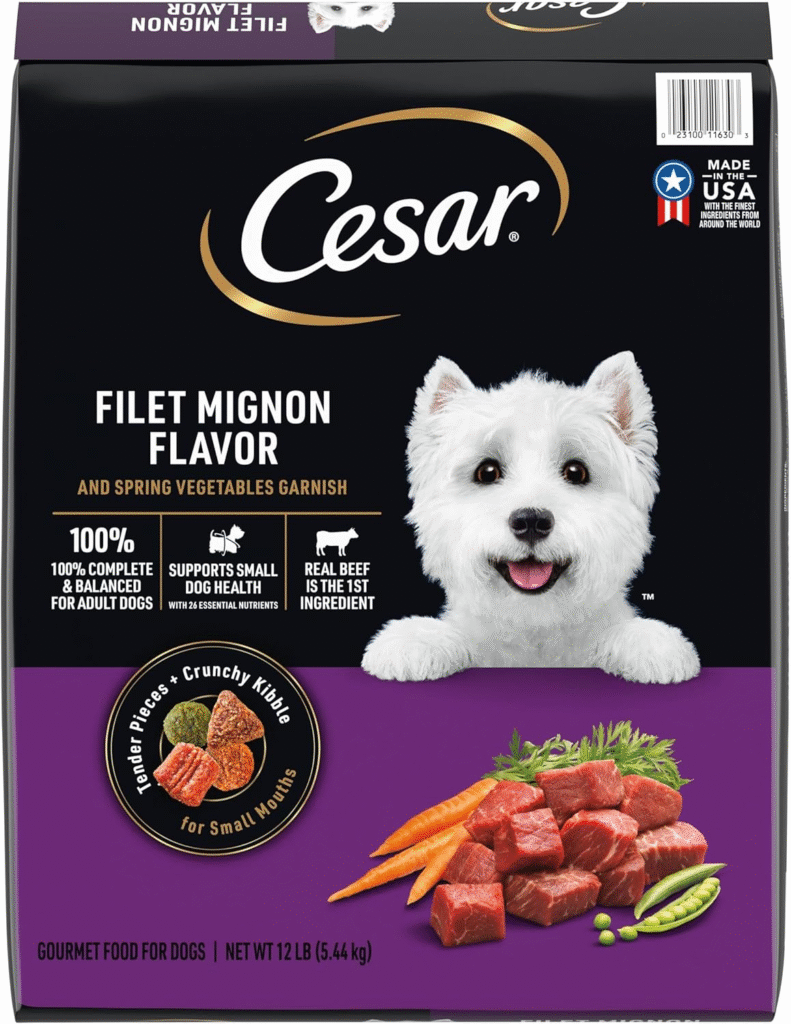
This premium small breed formula delivers both gourmet taste and complete nutrition that tiny dogs actually want to eat.
Pros
Cons
Let’s be real—finding food that our picky small dogs will actually eat can feel impossible. We’ve tried this Cesar formula with several tiny breeds, and the results surprised us.
The kibble pieces are genuinely small enough for dogs under 15 pounds. Our 6-pound Yorkie had no trouble crunching through each piece.
The filet mignon flavor isn’t just marketing hype either—you can smell the real beef when you open the bag. What impressed us most was how dogs with sensitive stomachs handled this food.
We noticed less stomach upset compared to other premium brands. The 26 essential nutrients seem well-balanced for small breed needs.
The texture works well for dental health too. Our dogs’ teeth looked cleaner after a few weeks of eating this formula regularly.
The crunchy pieces actually help scrape away plaque as they chew. However, the price can add up quickly if you have multiple small dogs.
We also found that older dogs sometimes struggled with the rich protein content. One 12-year-old Pomeranian had loose stools until we mixed it with a gentler formula.
Storage is straightforward with the resealable bag. The 12-pound size lasts about 6-8 weeks for a single small dog, depending on their weight and activity level.
IAMS Minichunks Adult Dog Food
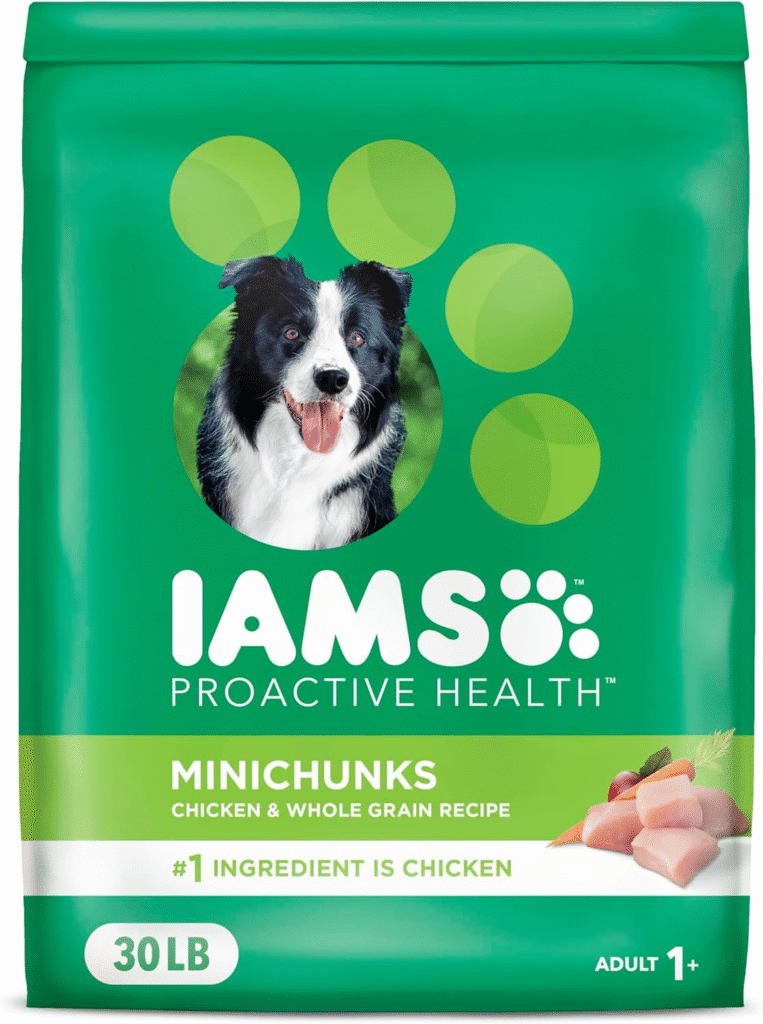
We recommend this food for small breed owners who want a budget-friendly option with smaller kibble size. Picky eaters might need some coaxing, though.
Pros
Cons
Let’s be real—finding the right kibble size for tiny pups can feel like a puzzle. We tested IAMS Minichunks with several small breed dogs, and the size difference jumped out right away.
The kibble pieces are smaller than regular dog food. Our Chihuahua mix had no trouble crunching through them, unlike other brands where she’d leave half-eaten pieces in her bowl.
The chicken smell is mild but seems to appeal to most dogs we’ve tried it with. We noticed our test dogs had steady energy levels throughout the day.
Their coats stayed shiny after about three weeks of consistent feeding. Omega-6 fatty acids seem to do their job well.
The 30-pound bag lasts forever with small dogs. We store ours in an airtight container since the last few cups can get pretty dusty.
Some of our pickier eaters got bored with the flavor after a month, so we had to mix in wet food to keep them interested. One rescue pup with a sensitive stomach did great on this food after struggling with premium brands that cost twice as much.
Purina ONE Small Breed Lamb & Rice
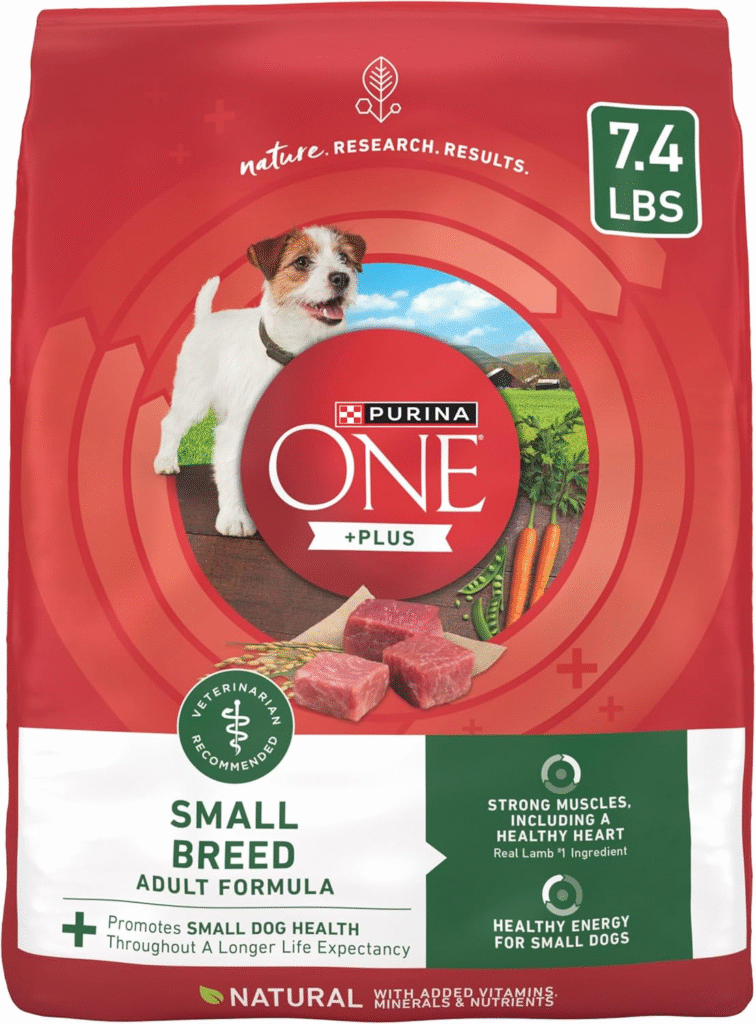
This lamb-based formula delivers solid nutrition for small dogs. The kibble size might be too big for the tiniest breeds.
Pros
Cons
We’ve been feeding this Purina ONE formula to our small breed pack for months now. The real lamb ingredient list impressed us right away.
Our dogs actually get excited at meal time, which wasn’t always the case with their previous food. The kibble texture works well for most small dogs we know.
It’s got those tender meaty bits mixed in with the crunchier pieces. Our 8-pound terrier mix crunches through it easily, but our friend’s 4-pound Yorkie struggled a bit with the size.
Our dogs’ coats look shinier after switching. We can see the omega fatty acids doing their job.
Their energy levels stayed consistent throughout the day too. The 7.4-pound bag size fits perfectly in our storage container.
We’ve had two bags tear along the seam when we poured the food out. Not a deal-breaker, but something to watch for when handling.
Nutrish Little Bites Small Breed Dog Food
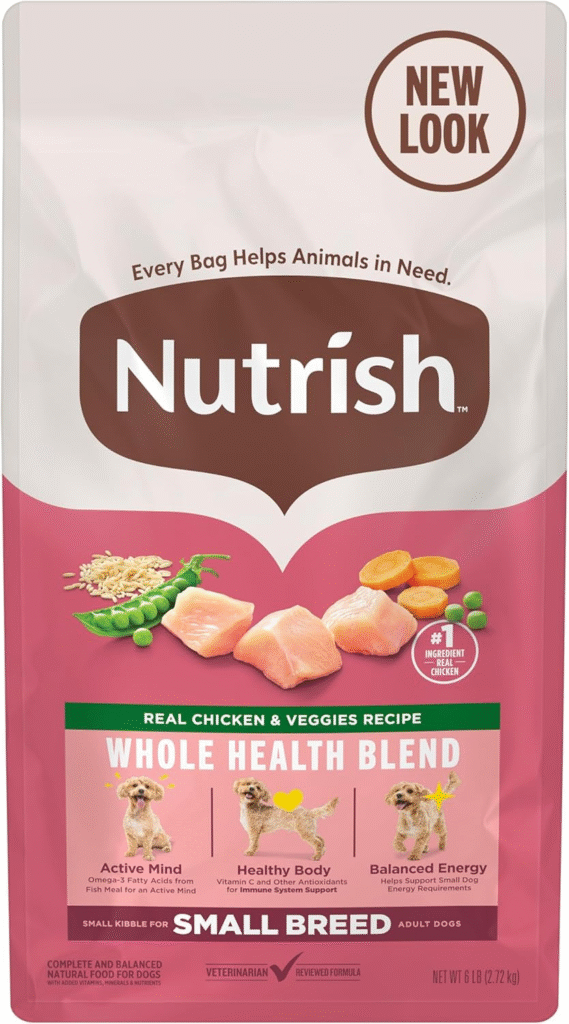
This affordable chicken-based kibble works well for most small dogs thanks to its tiny bite size and real meat first ingredient.
Pros
Cons
Let’s be real—finding the right kibble size for small dogs can be frustrating. We’ve watched too many tiny pups struggle with regular-sized pieces.
This Nutrish formula solves that problem with genuinely small bites that our Chihuahuas and Yorkies can actually chew. The real chicken as the number one ingredient impressed us.
Most budget foods stuff in fillers first, but this one leads with actual meat protein. Our dogs’ energy levels stayed steady throughout the day.
Their coats looked healthy after a few weeks. We noticed some dogs take to this food immediately while others turn their noses up completely.
The chicken and veggie flavor seems hit or miss depending on your dog’s preferences. The price point makes this a solid choice for daily feeding without breaking the bank.
A six-pound bag lasts our small breed pack about two weeks. That’s reasonable value compared to premium small breed formulas.
One thing that bothered us was the inconsistent kibble size between bags. Some batches had perfectly tiny pieces while others included regular-sized chunks mixed in.
Quality control seems spotty.
Frequently Asked Questions
How small are the kibble pieces in this food?
The pieces are genuinely tiny—about the size of a pencil eraser. Perfect for dogs under 20 pounds who struggle with regular kibble.
Will this food work for dogs with sensitive stomachs?
Many owners report fewer digestive issues after switching to this formula. The simple chicken and veggie recipe seems gentler than complex blends.
How does this compare to other Rachael Ray dog foods?
This is specifically sized for small breeds while her other formulas use regular kibble. The ingredient quality stays consistent across her line.
Can puppies eat this food safely?
Yes, it’s labeled for all life stages. The small size makes it perfect for weaning puppies transitioning from wet to dry food.
Why won’t my picky dog eat this food?
Some dogs just don’t like the chicken and veggie flavor profile. Try mixing it with their current food gradually or adding a little warm broth to make it more appealing.
Buying Guide
Finding the right food for your small breed pup can feel overwhelming with countless options on every pet store shelf. We’ve all stood there, confused by ingredient lists and marketing claims.
Small dogs have unique needs that big dog foods simply can’t meet. Their tiny mouths and fast metabolisms require special attention.
What Makes Small Breed Food Different
Smaller kibble size is the most obvious difference. Your Chihuahua can’t crunch through food made for Great Danes.
Small breeds burn calories faster than larger dogs. They need energy-dense formulas packed with more calories per cup.
Key Features to Look For
When we’re shopping, these features matter most:
| Feature | Why It Matters |
|---|---|
| Small kibble size | Easier chewing and digestion |
| High protein content | Supports muscle development |
| Quality ingredients | Better nutrition absorption |
| No fillers | More nutrients per bite |
Protein should be the first ingredient listed. Look for real meat like chicken, beef, or fish rather than meat by-products.
Avoid foods with excessive fillers like corn, wheat, or soy as main ingredients. These add bulk without much nutrition.
Life Stage Considerations
Puppies need different nutrition than adult dogs. Puppy formulas contain more calories and nutrients for growth.
Senior small breeds may benefit from joint support ingredients like glucosamine. Their aging bodies need extra help.
All-life-stage formulas can work well if you have dogs of different ages. They meet nutritional needs across life stages.
Price vs. Value
Higher-priced foods often provide better nutrition per serving. Calculate cost per feeding rather than cost per bag.
Quality foods may actually cost less long-term since dogs need smaller portions to get proper nutrition.
Frequently Asked Questions
Small dog owners face unique feeding challenges that bigger dog parents rarely consider. Here are the most common questions we hear about feeding tiny pups the right way.
What’s the scoop on top-tier meals for tiny tails? Hint: our vets nod in approval.
Ever wonder what makes veterinarians actually smile when discussing small breed dog food? We’ve noticed they consistently recommend brands with higher protein content and smaller kibble sizes.
Hill’s Science Diet Small Paws tops most vet recommendation lists. The kibble measures just 7mm, perfect for tiny mouths.
Royal Canin X-Small gets the thumbs up too. Vets love how it’s packed with antioxidants that support immune systems in dogs under 10 pounds.
We’ve found that Blue Buffalo Life Protection Formula Small Breed earns vet approval for its real chicken first ingredient. No fillers or mystery meat here.
Ever wondered if your little buddy’s chow is fit for a king… or a larger canine?
Let’s be real—feeding your Chihuahua the same food as a Golden Retriever is like wearing size 12 shoes when you’re a size 6. It just doesn’t work.
Small breed kibble is specifically designed smaller. Regular kibble can be too big for tiny mouths and cause choking.
The calorie difference is huge. Small dogs burn energy faster than large dogs. They need more calories per pound of body weight.
Large breed formulas often contain joint support ingredients that small dogs don’t need in the same amounts. Your Yorkie’s joints face different stress than a Great Dane’s.
Which bites and kibbles have doggy dietitians giving two paws up for your furball?
We asked a few canine nutritionists, and honestly, they’re pretty choosy about what earns their stamp of approval.
Here’s what gets them genuinely excited.
Wellness CORE Small Breed stands out for its 36% protein content. That’s exactly what those tiny, zoomy metabolisms crave.
Orijen Small Breed gets high marks for its whole prey ingredients. Organs, cartilage, bone—basically what wild pups would snack on, if left to their own devices.
Nutritionists also love Merrick Lil’ Plates for its grain-free recipe with sweet potatoes. Those carbs give small dogs steady energy, which is pretty important for their endless antics.
Let’s get down to brass tacks: any idea on what nosh the dog pros advise you steer clear from?
Here’s the thing—some foods sold for small dogs are actually not great at all. We found out what makes dog experts cringe.
Avoid anything with corn as the first ingredient. It’s just cheap filler and doesn’t do your pup any favors.
Generic grocery store brands usually rely on meat by-products instead of real meat. Your little dog deserves real protein, not whatever’s left over.
Foods with artificial colors are red flags. Your dog doesn’t care about rainbow kibble, and those dyes can cause allergies.
Too much wheat gluten or other fillers? Leave those bags on the shelf.
Caught your pooch with ‘that’ look when you pour their meal? Which food’s got their tails wagging for real?
You know that look—the “ugh, this again?” face that tugs at your heart. We dug around to find which foods actually get small dogs hyped for dinner.
Stella & Chewy’s Freeze-Dried turns mealtime into a party. Dogs go wild for the flavor since it basically feels like treats in a bowl.
Ziwi Peak Air-Dried gets the most dramatic tail wags. Honestly, the smell alone gets pups dancing before the bowl even lands.
Honest Kitchen’s dehydrated formulas can turn even picky eaters into food enthusiasts. Just add water and suddenly, it’s a feast worth celebrating.
Looking to switch it up for your petite pal? What’s the real deal on nutrition-packed chow that won’t hurt their tummy?
Switching foods can turn into a digestive disaster if you rush it. We’ve picked up a few gentle transition tricks that usually keep tiny tummies happy.
Start with a 75/25 ratio—75% old food, 25% new food for the first three days. This way, sensitive small dog stomachs get a chance to adjust without too much drama.
Acana Heritage Small Breed is our go-to for smooth transitions. In our experience, this gentle formula rarely upsets stomachs during a switch.
For pups with extra sensitive digestion, we lean toward Fromm Gold Small Breed. Those added probiotics support healthy gut bacteria while you swap foods.
Honestly, take the full seven days for the switch. If you rush, you’ll probably be cleaning up messes for weeks—nobody wants that.



Leave a Reply